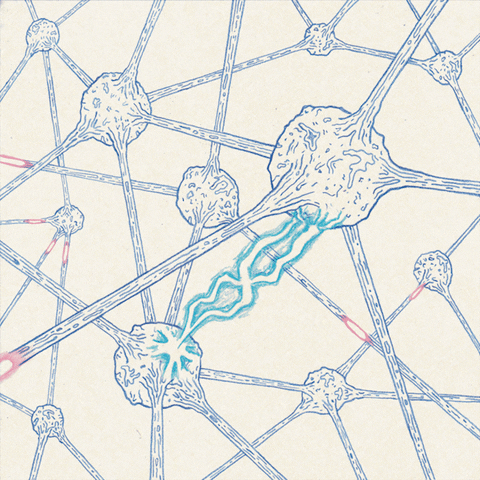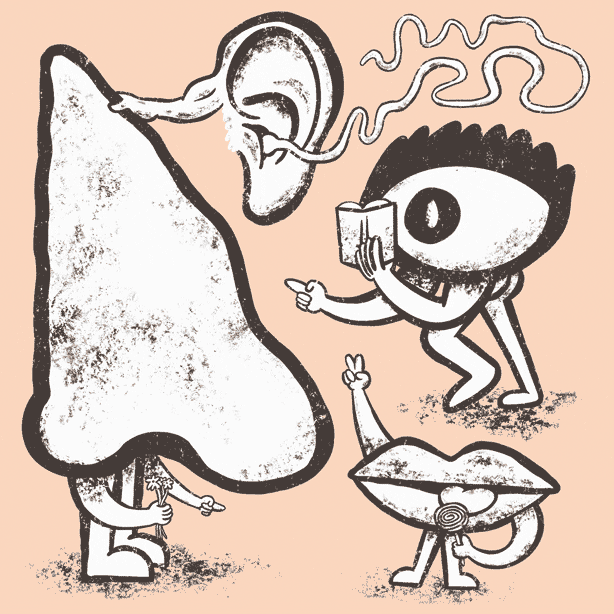🧠 How Your Brain Works
Part 1 of my notes for the Huberman Lab Podcast #1. Click here to read part 2.
Everything you think, remember, feel and imagine from the day you're born to the day you die is a continuous loop of communication within your nervous system.
The nervous system both governs and is influenced by all other biological systems in the body.
It is made out of nerve cells called neurons, which are connected to one another via neural synapses. These cells communicate by passing chemicals around which trigger an electricity response and in turn activate some cells but not others.
💡 The language of the nervous system is electricity⚡.
- Image credit: palerlotus
Depending on which cells are active you might be lifting or lowering your arm, you might be seeing something and perceiving that it's green, or seeing someone and recognizing who they are. All of that corresponds to particular nerve cells being active in a particular order at a given moment.
Our experiences, our memories are sort of like keys of a piano 🎹 being played in a particular order and with particular intensity to produce a specific song.
Memories are essentially stored as patterns of electrical impulses on these neurons that, when repeated, give you the sense that you're experiencing that thing again.
In fact, the sense of déjà vu means that the neurons that were active in one circumstance are becoming active in the same circumstance again.
We even have dedicated neurons that are only activated when we recognize people.
💡 Our brain is a map of our experience.
Components of the nervous system
Sensation
Our entire experience of life is filtered through our sensory receptors.
We can only perceive what our senses allow us.
Every living being has a nervous system with neurons that get activated based data from their senses, some of which are quite different to humans. For example, 🐍 viper snakes have infrared vision and certain species of 🐢 turtles can "smell" magnetic fields.
💡 Sensation is non-negotiable. We cannot control it, it's always happening.
Perception
Perception is our ability to take what we're sensing and focus on it, make sense of it, explore it, remember it.
💡 Perception is really just whatever sensation we happen to be paying attention to in any moment.
Perception happens when we focus on a sensation but sensation is happening all along.
Perception is negotiable (you can change it!). It is controlled by your two 🔦attentional spotlights, which you can split across two locations (for example watching a video and enjoying a meal) or focus them both on the same location.
You can also control dilate your attention spotlight or make it more concentrated, sort of like zooming in and out.
Note that your control over your attentional spotlights depends on how rested you are. You might've noticed that when you're groggy, it's harder to focus.
Feelings/Emotions
Neurons are electrically active but they also release chemicals.
Neuro-modulators is a category of chemicals that has a profound influence on our emotional states. Things like Dopamine, Serotonin, Acetylcholine, Epinephrine...
💡 Neuro-modulators bias which neurons are likely to be active and which ones are likely to be inactive.
One way to think of neuro-modulators is as playlists for certain musical categories. The jazz neuro-modulator will trigger a different sequence from the punk one.
Cells have receptors where these neuro-modulators can get attached. You can sort of think of them as parking spots. Depending on where they park, the effect of each neuro-modulator can be quite different.
Increasing or decreasing the presence of neuro-modulator can cause them to park into (or move out of) various receptors in your body, with mixed effects. This is why, for examples, some anti-depressants can both make a person feel better and cause a loss of libido or appetite.
It's important to know that feelings and emotions are both contextual and social.
Thoughts
We typically think of emotions as reflexive.
Thoughts can be reflexive as well. However, thoughts also allow us to guide emotions in a deliberate way.
Deciding to do something or not to do something requires effort and engages in top down deliberate action. This feels like agitation because it's accompanied by the release of a neuro-modulator called Epinephrine.
This is why it feels challenging to learn something, or be wary of your responses or actions.
Changing yourself by leveraging your brain's neuroplasticity requires top-down processing and this feeling of agitation and strain.
💡 Agitation and strain is the entry point to this neuroplasticity.
Actions
Actions and behaviors are the only thing that will create any kind of physical record of our existence. For all humans, none of our sensations, perceptions, emotions and thoughts are carried forward except the ones that we convert into actions such as words, writing, engineering new things.
💡 Movement is the final common pathway. - Sir Charles Sherrington
Movement is created through central pattern generators and, just like thoughts, can be either reflexive (walking) or deliberate (i.e. climbing something difficult).
The actions of the nervous system can be split into reflexive and deliberate.
The nervous system wants to pass off as much as it can to reflexive action. That's called bottom-up processing - information is flowing in through your senses, regardless of what you're perceiving, and it's directing your activity.
At any moment though, let's say a car honks really loudly behind your back, you're now moving into deliberate action. This is called top-down activity - it requires effort and focus.
💡 Deliberate, top-down activity always requires some effort while reflexive bottom up activity feels effortless.
A deliberate action involves bringing your attention to an analysis of 3 things (called together under the acronym DPO):
- Duration - how long something is gonna take or should be done
- Path - what you should be doing
- Outcome - if you do something for a given length of time, what's going to happen
Impulsivity is a lack of top-down control. For example, children have little capacity for top-down control. For them everything is a stimulus and they have a hard time restricting their behavior or restricting their speech.
Alcohol also makes it harder to do top-down processing → neural inhibition.
Plasticity is a process of altering neuron connections such that things go from challenging and deliberate to being reflexive.

